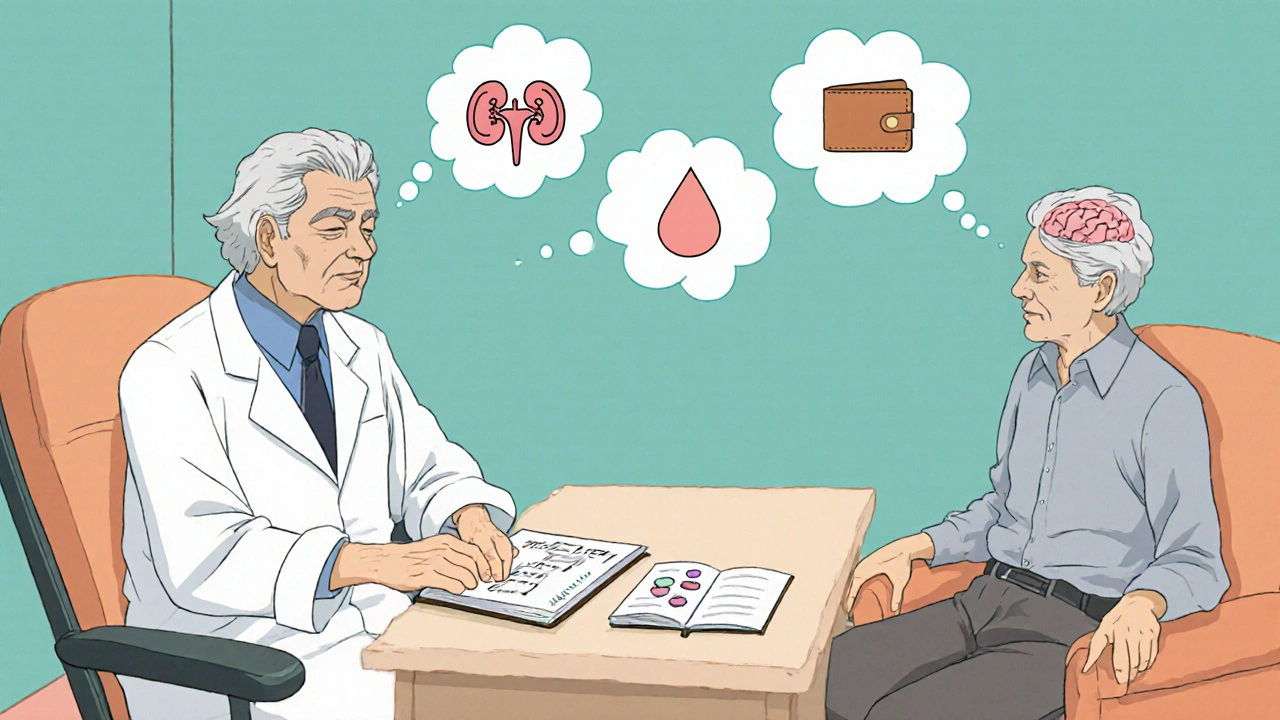Bladder Medication Decision Tool
Find Your Best Bladder Medication
This tool helps determine which bladder muscle relaxant is most appropriate based on your symptoms, side-effect tolerance, and health factors. Based on information from the article "Flavoxate (Urispas) vs. Other Bladder Muscle Relaxants: Pros, Cons, and Alternatives"
Your Symptoms
Your Health Factors
Recommended Option
Why this recommendation?
When the bladder muscles start acting up, many turn to a muscle relaxant to calm the spasm. Flavoxate (brand name Urispas) is one of those options, but it’s not the only game in town. In this guide we break down how Flavoxate stacks up against the most common alternatives, so you can see which drug fits your symptoms, lifestyle, and health profile.
What is Flavoxate (Urispas)?
Flavoxate is a antispasmodic medication specifically designed to relax the smooth muscle of the urinary bladder. It works by inhibiting calcium influx in detrusor muscle cells, which reduces involuntary contractions without affecting bladder emptying. First approved in the 1970s, Flavoxate is marketed under the brand name Urispas and is typically prescribed for urinary frequency, urgency, and mild overactive bladder (OAB) symptoms.
Its main selling point is a lower incidence of dry mouth compared to many anticholinergic alternatives, making it attractive for patients who struggle with that side effect.
How Does Flavoxate Differ From Anticholinergics?
Most bladder‑relaxing drugs belong to the anticholinergic class - they block acetylcholine receptors to dampen bladder activity. Flavoxate, however, is not an anticholinergic; it targets muscle calcium channels directly. This mechanistic difference means Flavoxate tends to preserve cognitive function and causes less constipation, but it may be less potent for severe OAB.
Key Alternatives to Flavoxate
- Oxybutynin is an anticholinergic that has been a go‑to for OAB for decades. It reduces bladder muscle contractions by blocking muscarinic receptors.
- Tolterodine offers a similar anticholinergic effect but with a more selective receptor profile, which can lessen some side effects.
- Solifenacin is a once‑daily anticholinergic known for its long half‑life and steady symptom control.
- Darifenacin provides high selectivity for the M3 muscarinic receptor, targeting bladder muscle while sparing salivary glands.
- Trospium is a quaternary ammonium anticholinergic that does not cross the blood‑brain barrier easily, offering a lower risk of cognitive side effects.
Comparison Table: Flavoxate vs. Main Anticholinergic Alternatives
| Drug | Mechanism | Typical Dose | Common Side Effects | Onset of Relief | Prescription Status (2025) |
|---|---|---|---|---|---|
| Flavoxate (Urispas) | Calcium‑channel inhibition in detrusor muscle | 200‑400 mg 2‑3×/day | Dizziness, mild GI upset | 3‑5 days | Rx (generic available) |
| Oxybutynin | Muscarinic (M1‑M3) receptor blockade | 5‑10 mg 2‑3×/day (or 5 mg extended‑release QD) | Dry mouth, constipation, blurred vision | 1‑2 days | Rx (brand and generic) |
| Tolterodine | Selective muscarinic blockade (M2‑M3) | 2‑4 mg BID or 4 mg extended‑release QD | Dry mouth, headache, nausea | 2‑3 days | Rx (generic available) |
| Solifenacin | Muscarinic M3 receptor antagonist | 5‑10 mg QD | Constipation, dry mouth, blurred vision | 3‑5 days | Rx (generic approved 2024) |
| Trospium | Quaternary anticholinergic, low CNS penetration | 20 mg BID | Dry mouth, urinary retention (rare) | 4‑7 days | Rx (generic available) |

When Might Flavoxate Be the Better Choice?
If you’ve tried anticholinergics and found the dry‑mouth or constipation unbearable, Flavoxate offers a gentler profile. It’s also a solid option for patients with mild cognitive concerns, as it doesn’t block central acetylcholine pathways. For people with primarily irritative symptoms (urgency, frequency) but intact bladder emptying, Flavoxate’s modest muscle‑relaxing effect can be sufficient.
However, its efficacy plateau appears around moderate‑to‑severe OAB. In those cases, anticholinergics or newer β‑3 agonists (like mirabegron) usually outperform Flavoxate.
Side‑Effect Landscape: What to Watch For
Every medication carries trade‑offs. Below is a quick rundown of the most frequently reported adverse events for each drug.
- Flavoxate: Dizziness, mild gastrointestinal discomfort, rare skin rash.
- Oxybutynin: Pronounced dry mouth, constipation, potential for blurred vision; in older adults, an increased risk of tachycardia.
- Tolterodine: Similar anticholinergic profile but with slightly lower rates of dry mouth.
- Solifenacin: Notable constipation and occasional urinary retention.
- Trospium: Minimal cognitive effects but can cause urinary retention in patients with prostate enlargement.
Choosing the right drug often means balancing the severity of bladder symptoms against which side‑effect you can tolerate best.
Special Populations: Age, Pregnancy, and Kidney Function
Flavoxate is primarily eliminated unchanged via the kidneys. Dose adjustments are recommended for patients with creatinine clearance < 30 ml/min. In contrast, many anticholinergics are metabolized hepatically, making them safer for severe renal impairment but riskier for hepatic disease.
Pregnancy data for Flavoxate are limited; most clinicians avoid it in the first trimester and prefer non‑pharmacologic strategies unless symptoms are disabling. Anticholinergics are generally classified as Pregnancy Category C, meaning risk cannot be ruled out.
For the elderly, the cognitive safety of Flavoxate is a clear advantage. Trospium is another elderly‑friendly option because of its poor blood‑brain barrier penetration.

Cost and Accessibility in 2025
Generic Flavoxate tablets typically cost around $0.15 per 200 mg tablet in the U.S., translating to roughly $30‑$40 for a month’s supply. Oxybutynin generic is slightly cheaper at $0.12 per tablet, but extended‑release brand versions can exceed $120 per month. Solifenacin’s generic entered the market mid‑2024, bringing the price down to about $0.25 per 5 mg tablet.
Insurance coverage varies; many plans place anticholinergics on tier‑2 formularies, while Flavoxate often lands on tier‑1 due to its older patent status.
Practical Decision‑Making Checklist
- Assess symptom severity: Mild‑moderate urgency/frequency → consider Flavoxate; severe urge incontinence → anticholinergic or β‑3 agonist.
- Review comorbidities: Cognitive impairment or dry‑mouth sensitivity → favor Flavoxate or Trospium.
- Check renal/hepatic function: Reduced clearance → dose‑adjust Flavoxate; liver disease → prefer Flavoxate over metabolized anticholinergics.
- Evaluate cost/coverage: Generic availability often drives choice; verify pharmacy formulary.
- Trial period: Start low, monitor side‑effects for 2‑4 weeks before switching.
Bottom Line: Tailor the Therapy to the Patient
There’s no one‑size‑fits‑all bladder drug. Flavoxate shines when the goal is modest symptom relief without anticholinergic baggage. Anticholinergics dominate the market for stronger OAB control but demand vigilance about dry mouth, constipation, and potential cognitive impact. By weighing mechanism, side‑effect profile, patient age, organ function, and cost, clinicians can pinpoint the most suitable agent.
Frequently Asked Questions
What is the main difference between Flavoxate and Oxybutynin?
Flavoxate relaxes bladder smooth muscle by blocking calcium channels, while Oxybutynin blocks muscarinic receptors. This makes Flavoxate less likely to cause dry mouth and cognitive changes.
Can I switch from an anticholinergic to Flavoxate without a washout period?
Usually yes. Because the mechanisms differ, a short overlap (1‑2 days) is safe for most patients, but always check with your prescriber, especially if you have heart or kidney issues.
Is Flavoxate safe for seniors with mild dementia?
Yes, it is generally considered safer for cognition than anticholinergics, which can worsen confusion. Monitor for dizziness, though.
How long does it take for Flavoxate to start working?
Patients typically notice reduced urgency within 3‑5 days of consistent dosing.
Are there any drug‑interaction concerns with Flavoxate?
Flavoxate has a low interaction potential, but co‑administration with other calcium‑channel blockers may increase hypotension risk. Always list all meds for your doctor.
Armed with these comparisons, you can discuss with your healthcare provider which bladder medication aligns best with your daily life and health status.


Abby W
October 24, 2025 AT 21:57Flavoxate skips the nasty dry‑mouth side‑effect that haunts most anticholinergics 😅. It works by calming the detrusor muscle without blocking acetylcholine, so your brain stays sharp. For patients who can’t tolerate constipation, it’s a decent middle‑ground. Just keep an eye on dizziness, especially when you stand up fast 🚀.
Lisa Woodcock
October 24, 2025 AT 23:37From a cultural‑sensitivity standpoint, the choice of bladder medication often reflects a patient’s lifestyle and health beliefs. Flavoxate’s milder anticholinergic profile can be appealing for those who value mental clarity. It also tends to be more affordable in many formularies, reducing financial strain. Overall, it fits nicely into a holistic care plan.
Sarah Keller
October 25, 2025 AT 01:17When we examine Flavoxate in the grand tapestry of bladder therapeutics, several philosophical threads emerge. First, its calcium‑channel inhibition represents a departure from the cholinergic orthodoxy that dominates OAB treatment. By eschewing central acetylcholine blockade, it preserves cognitive integrity, a virtue often overlooked in cost‑driven formularies. Second, the drug’s modest efficacy aligns with the principle of therapeutic minimalism: provide enough relief to improve quality of life without over‑medicalizing a natural bodily function. Third, the side‑effect spectrum-dizziness and mild GI upset-mirrors the Aristotelian mean, avoiding extremes of severe constipation or profound xerostomia. Fourth, renal elimination underscores a respect for organ‑specific pharmacokinetics, offering a logical alternative for patients with hepatic compromise. Fifth, the rapid onset of relief (3‑5 days) satisfies the pragmatic desire for timely symptom control while acknowledging the body’s need for gradual adaptation. Sixth, its generic status democratizes access, reinforcing the ethical imperative of equity in healthcare. Seventh, the drug’s lack of anticholinergic burden reduces the risk of delirium in the elderly, aligning with the principle of non‑maleficence. Eighth, the relatively low cost per tablet translates into a tangible economic benefit for both patients and insurers. Ninth, the dosing flexibility (200‑400 mg 2‑3×/day) permits individualized regimens that respect patient autonomy. Tenth, the minimal interaction profile with other calcium‑channel blockers lessens the likelihood of iatrogenic hypotension, an oft‑ignored safety net. Eleventh, the therapeutic window, though narrower than high‑potency anticholinergics, is sufficient for mild‑to‑moderate symptoms, embodying the virtue of temperance. Twelfth, patient narratives frequently cite the preservation of taste and salivation as a quality‑of‑life enhancer, a subtle but meaningful outcome. Thirteenth, the drug’s longevity on the market (since the 1970s) provides a robust evidence base, satisfying the epistemic demand for long‑term safety data. Fourteenth, the oral tablet form ensures ease of administration compared to transdermal patches or injectables, respecting the principle of practicality. Fifteenth, in comparative studies, Flavoxate’s side‑effect profile consistently ranks lower for cognitive decline, a fact that should inform guideline panels. In sum, Flavoxate embodies a balanced, patient‑centric philosophy that warrants serious consideration alongside its anticholinergic counterparts.
Veronica Appleton
October 25, 2025 AT 02:57Flavoxate works by easing muscle tension it doesn’t shut down the whole system so you still empty fully
Side effects are usually mild like a little dizziness or upset stomach
Cheap generic makes it easy on the wallet
the sagar
October 25, 2025 AT 04:37The pharma elite hide the truth about Flavoxate’s side effects.
Grace Silver
October 25, 2025 AT 06:17While Sarah laid out the philosophical scaffolding I want to stress the practical implications. Flavoxate’s safety in the elderly is not just a theory-real‑world data show fewer falls linked to dizziness compared to anticholinergics. Also, for patients on multiple meds, the low interaction risk simplifies regimen management. The trade‑off is that you may need a longer trial to gauge efficacy. Nonetheless, its cognitive sparing benefits often outweigh the modest potency gap.
Clinton Papenfus
October 25, 2025 AT 07:57It is with great respect that I present the comparative data regarding Flavoxate and its consort. The drug demonstrates a favourable side‑effect profile and cost efficiency. Accordingly it should be considered a viable first‑line option in appropriate clinical contexts.
Zaria Williams
October 25, 2025 AT 09:37i gotta say flavo is kinda sus dont u think theyd hide sth? its cheap an easy but why the noise bout dry mouth? maybe its just hype
ram kumar
October 25, 2025 AT 11:17Ah, the grand theatre of pharmacy! One watches as the curtain lifts on Flavoxate, a modest performer amidst the blaring trumpets of anticholinergics. Its gentle hand on the bladder may seem underwhelming, yet it whispers a promise of cognitive safety-a subtlety lost in the roar of side‑effect headlines. The drama unfolds when cost, accessibility, and patient preference collide, revealing the true hero in the backstage. In the end, the audience decides: spectacle or subtlety?
Melanie Vargas
October 25, 2025 AT 12:57Great point, Zaria! 😊 Flavoxate’s lower dry‑mouth risk really helps people stay comfortable 🙌. And the kidney‑based dosing is a smart fit for those with liver concerns. Keep sharing these insights! 🌟
Deborah Galloway
October 25, 2025 AT 14:37I really appreciate the balanced view here-thanks for breaking down the pros and cons so clearly.
Charlie Stillwell
October 25, 2025 AT 16:17Hmm, the data sounds shiny but remember the R&D hype 🚀. Generic jargon aside, the real‑world adherence often drops when patients notice even mild dizziness. 🤷♂️
Ken Dany Poquiz Bocanegra
October 25, 2025 AT 17:57Flavoxate offers a gentle approach that many patients can tolerate, especially when cost is a concern. It may not be the strongest option for severe OAB, but its safety profile makes it worth a trial before moving to heavier anticholinergics.
krishna chegireddy
October 25, 2025 AT 19:37Look, the pharma giants don’t want you to know the simple truth-Flavoxate is the hidden gem and the big brands are just a distraction. It’s safe, cheap, and they’re trying to hide that.